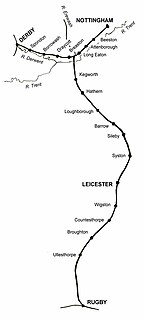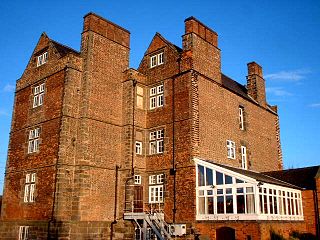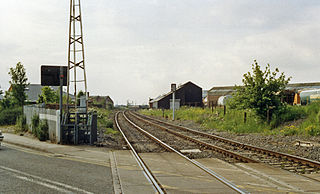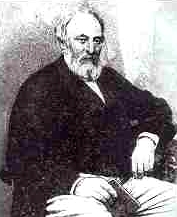
The London, Midland and Scottish Railway (LMS) was a British railway company. It was formed on 1 January 1923 under the Railways Act of 1921, which required the grouping of over 120 separate railways into four. The companies merged into the LMS included the London and North Western Railway, Midland Railway, the Lancashire and Yorkshire Railway, several Scottish railway companies, and numerous other, smaller ventures.

The Midland Railway (MR) was a railway company in the United Kingdom from 1844. The Midland was one of the largest railway companies in Britain in the early 20th century, and the largest employer in Derby, where it had its headquarters. It amalgamated with several other railways to create the London, Midland and Scottish Railway at grouping in 1922.

The Midland Counties' Railway (MCR) was a railway company in the United Kingdom which existed between 1839 and 1844, connecting Nottingham, Leicester and Derby with Rugby and thence, via the London and Birmingham Railway, to London. The MCR system connected with the North Midland Railway and the Birmingham and Derby Junction Railway in Derby at what become known as the Tri Junct Station. The three later merged to become the Midland Railway.

Melbourne is a market town and civil parish in South Derbyshire, England. It was home to Thomas Cook, and has a street named after him: Thomas Cook Close. It is about 8 miles (13 km) south of Derby and 2 miles (3 km) from the River Trent. The population of the civil parish at the 2011 Census was 4,843.

The London Midland and Scottish Railway's class 8F is a class of steam locomotive designed for hauling heavy freight. 852 were built between 1935 and 1946, as a freight version of William Stanier's successful Black Five, and the class saw extensive service overseas during and after the Second World War.

The Longmoor Military Railway (LMR) was a British military railway in Hampshire, built by the Royal Engineers from 1903 in order to train soldiers on railway construction and operations. The railway ceased operation on 31 October 1969.

The Midland Railway 1377 Class was a class of 185 0-6-0T tank locomotives. They were introduced in 1878 by Samuel W. Johnson, and were almost identical to the 1102 class of 1874; the latter having fully enclosed cabs, while the 1377 class were built without a rear to the cab and only a short cab roof, hence their nickname "half-cabs". They were given the power classification 1F.

Weston-on-Trent is a village and civil parish in the South Derbyshire district of Derbyshire. The population of the civil parish at the 2011 census was 1,239. It is to the north of the River Trent and the Trent and Mersey Canal. Nearby places include Aston-on-Trent, Barrow upon Trent, Castle Donington and Swarkestone.
The Stafford and Uttoxeter Railway was authorised by Act of Parliament on 29 July 1862, to build a line between the towns in its title, in Staffordshire, England. It opened for traffic in 1867. It was nicknamed the Clog and Knocker. It opened on 23 December 1867. Construction cost had much exceeded estimates, and income was poor, so that the Company was always in financial difficulty. It was placed in receivership in 1875. The Great Northern Railway (GNR) had running powers to Uttoxeter and was persuaded to acquire the Company, which it did in 1881. The GNR spent a considerable sum on improving the line, but it never made money and it was closed to passengers on 4 December 1939. Goods traffic ceased in 1951, except for a short stub to RAF Stafford; this too closed in 1975.

The Leicester–Burton upon Trent line is a freight-only railway line in England linking the Midland Main Line south of Leicester to the Cross Country Route at Burton-on-Trent. The line closed to passengers in the 1960s, since when various proposals have been made to reopen it.

John Joseph Briggs, naturalist and topographer, was born in the village of Kings Newton, Derbyshire on 6 March 1819. His father, John Briggs, who married his cousin, Mary Briggs, was born and resided for 88 years on the same farm, at Kings Newton, which had been the freehold of his ancestors for three centuries.

The Ashby and Nuneaton Joint Railway was a pre-grouping railway company in the English Midlands, built to serve the Leicestershire coalfield. Both the Midland Railway and the London and North Western Railway (LNWR) wished to build a line on similar alignments, and they agreed to build jointly. Construction began in 1869 and the railway was opened in 1873. It linked Moira and Coalville with Nuneaton. Mineral traffic was busy, and the line formed a useful link for through goods trains. Some long distance passenger operation took place over the line, but it was never successful in carrying passengers.

Ashby de la Zouch railway station is a former railway station at Ashby de la Zouch in Leicestershire on the Leicester to Burton upon Trent Line. The Midland Railway opened it in 1849 and British Railways closed it in 1964.

The Castle Donington line also known as Weston On Trent Branch Railway is a railway line in Derbyshire, England, that runs between Stenson Junction in the west and Sheet Stores Junction in the east. There are no passenger services that serve this line regularly but passenger services are occasionally routed across it. Regular passenger services are routed via Derby. The line is regularly used by freight trains and serves the East Midlands Gateway freight interchange. There are no current passenger stations on the line which previously served stations at Castle Donington and Weston-on-Trent and also linked to the Melbourne Line.
Sir Cecil Walter Paget, was an English locomotive engineer and railway administrator. Cecil Paget was the son of Sir George Ernest Paget, Chairman of the Midland Railway Company (MR) 1890-1911.

Melbourne railway station was a station at Kings Newton that served the adjacent town of Melbourne, Derbyshire, England.
Chellaston and Swarkestone railway station was a station at Chellaston in Derbyshire, England.
Worthington railway station was a station at Worthington, Leicestershire, England.

The Burton and Ashby Light Railway was a tramway system operating between Burton upon Trent and Ashby-de-la-Zouch between 1906 and 1927.

The LNWR 5ft 6in Tank was a class of 160 passenger 2-4-2T locomotives manufactured by the London and North Western Railway in their Crewe Works between 1890 and 1897. The "5ft 6in" in the title referred to the diameter of the driving wheels – although the stated dimension was for the wheel centres – the nominal diameter including the tyres was 5 ft 8+1⁄2 in (1,740 mm).



















